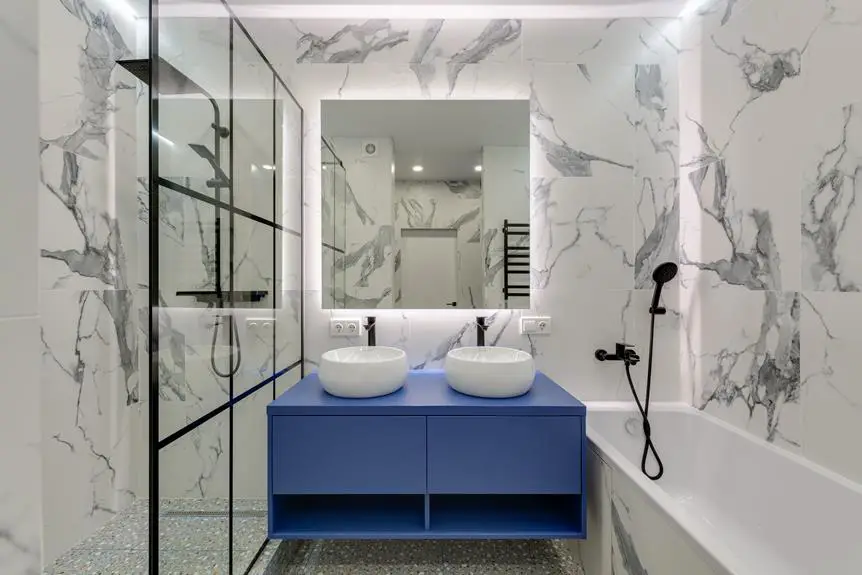Bathroom sink depths typically range from 5 to 8 inches. This size allows for various uses while reducing water splashing. The right sink depth improves comfort, water drainage, and maintenance.
When choosing a sink, consider its practicality, the size of the bathroom, and how it fits with the design. Selecting the proper depth is important for the bathroom's functionality and style.
Understanding Sink Depth Importance
The depth of a bathroom sink is an important feature that affects its use and comfort. Bathroom sinks usually have a depth ranging from 5 to 8 inches, a standard that balances function and ease of use. Depth impacts tasks like washing hands, brushing teeth, and face-washing. Too deep a sink may be hard to use for short people or children and difficult to clean. A shallow sink can cause water to splash out, creating messes.
Standard sink sizes are meant to suit various needs and fit different bathroom styles. When installing an undermount sink, the depth should be considered along with the countertop thickness to ensure a comfortable height. To measure a sink, one should consider the internal depth to the overflow and the overall size.
Sink depth should also be chosen based on the bathroom size, user preference, and design. A proper sink depth ensures functionality, accessibility, and style without sacrificing comfort.
Standard Bathroom Sink Measurements
Standard bathroom sink depths range from 5 to 8 inches. The lengths of these sinks can range from 10 to 60 inches, and the widths can range from 10 to 25 inches. These dimensions are designed to accommodate various styles and space limitations, ensuring both style consistency and practicality. It is important to consider the size of the sink for functionality and ease of use. A sink that is too deep can cause discomfort, while a sink that is too shallow may result in splashing. Manufacturers offer a wide range of sizes to meet different needs and preferences. Undermount sinks also vary in depth, typically ranging from 4 to 7 inches. When choosing a sink, it is important to consider factors such as the size of the bathroom, intended use of the sink, style preferences, and plumbing requirements.
Impact on Bathroom Usability
Choosing the right bathroom sink depth is important for user comfort and functionality. Sink depths range from shallow to deep, affecting how the sink is used. Deep sinks can hold more items and reduce splashing, but may be uncomfortable for some users. A moderate sink depth of 5 to 8 inches balances usability and comfort, preventing splashes and remaining accessible, particularly for those with mobility issues.
Shallow sinks save space and are easier to clean but may be impractical for large items. Designs like semi-recessed or vessel sinks provide depth without sacrificing comfort. The depth of a bathroom sink is a key factor in its practicality and should be selected with care.
Choosing the Right Sink Depth
When selecting a bathroom sink depth, consider the user needs and room size. The typical depth range is 5 to 8 inches, suitable for most people. Personal preference and bathroom design are also important. A sink that's too deep can cause discomfort and be hard to clean, while one that's too shallow may lead to water splashing out.
In small bathrooms, a shallower sink helps save space. Larger bathrooms can fit deeper sinks without issues. Consider the sink style; vessel sinks can be deeper but remain user-friendly as they are on top of the counter.
For those with mobility issues, choose a sink depth that's easily accessible. Undermount sinks usually offer depths between 4-7 inches and may have sloping designs for better access.
Selecting the right depth ensures the sink is functional and aesthetically pleasing.
Bathroom Sink Depth Variations
Bathroom sink depth varies to meet different needs and preferences, with depths ranging from shallow to deep.
Vessel sinks are typically wider and deeper, often more than the standard 5 to 8 inches, and are chosen for both their looks and functionality.
Undermount sinks, which are installed under the countertop, range from 4 to 8 inches in depth, with some designed to slope towards a deeper center for effective water drainage.
Drop-in sinks, which have edges that rest on the countertop, come in various depths to reduce splashing and are functional for everyday bathroom activities. They integrate with the countertop for a uniform appearance.
For unique situations, semi-recessed or vessel sinks provide deep basins without using too much space, and double-bowl sinks allow for multiple uses at once.
Custom sinks are also an option for specific needs, allowing for personalized depth.
These different sink depths help homeowners balance aesthetics, space, and functionality in their bathrooms.





